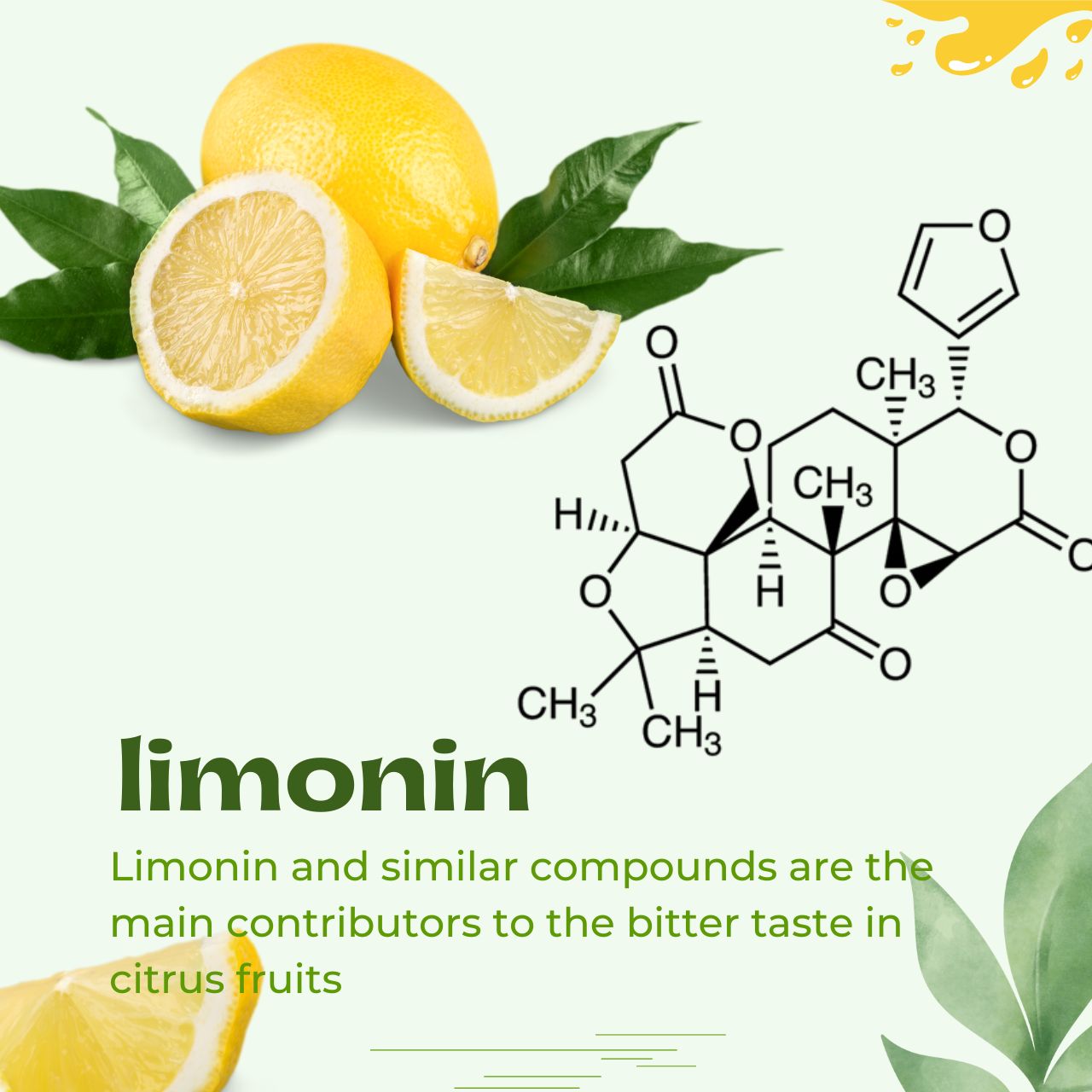Limonin and similar compounds are the main contributors to the bitter taste in citrus fruits, predominantly accumulating in the fruits of the Citrus genus, particularly in the seeds. It is a white crystalline substance with a bitter taste. Limonin exhibits certain anti-cancer and antiviral properties along with other beneficial bioactivities.
Basic Information
English Name: Limonin
CAS: 1180-71-8
Molecular Formula: C26H30O8
Molecular Weight: 470.53
Chemical Name: Limonoate D-ring-lactone; Limonoic acid di-delta-lactone
Presence: Found in lemons or other citrus fruits
Characteristics: White crystalline substance with a bitter taste
Extraction Source: Citrus fruits such as oranges, grapefruits, lemons, and tangerines
Solubility: Soluble in ester-based organic solvents, sparingly soluble in water, with higher solubility in methanol and ethanol
Melting Point: 298°C
Specifications: 30%, 90%, 95%, 98%
Detection Method: HPLC
Appearance: Yellow-brown or light yellow or white fine powder Product
Packaging: 1kg/pack; 25kg/cardboard drum; or customized packaging according to customer requirements
Storage: Keep in a sealed container, store in a cool, dry place, ensure good ventilation or exhaust in the workplace
Pharmacological Effects: Limonin and its analogs exhibit various biological activities such as anti-tumor, insect repellent, antiviral, analgesic, anti-inflammatory, and sedative
properties Stability: If used and stored according to specifications, it will not decompose, with no known hazardous reactions, avoiding oxidants.
Taste Function
Limonin and similar compounds are the primary cause of bitterness in citrus fruits. Researchers have proposed methods for removing bitterness from products such as bitter orange juice using polymer films. Limonin-like compounds are mainly present in the fruits of Rutaceae plants such as citrus fruits (navel oranges, mandarins, sweet oranges) and grapefruits. They are most abundant in the seeds and less so in the peel (about one in ten thousand to one in fifty thousand). Over fifty limonin-like compounds have been isolated and identified from Citrus plants, including limonin, Nomilin, Deacetylnomilin, Obacunone, and Nomilinic acid, among others, all of which are triterpenoid compounds containing a furan ring.
Bioactivity
Limonin exhibits various biological activities such as anti-tumor, insect repellent, antiviral, analgesic, anti-inflammatory, and sedative properties. It can be used in functional food additives, anticancer foods, insecticides, feed additives, etc.
Misconceptions
Although limonin from citrus fruits shows potential in developing anticancer drugs, related research is not yet mature and is far from clinical application. It is certain that claims suggesting limonin “has been proven to treat all types of cancer” are incorrect. Additionally, citrus fruits cannot replace proper cancer treatment methods, and treatment should always follow medical advice.
Methods for Removing Bitterness from Citrus Juice
Metabolism-based Bitterness Removal
It has long been observed that citrus juice extracted from late-harvested fruits is less bitter than that from early-harvested fruits. Inspired by this phenomenon, various methods have been developed to accelerate the metabolism of bitter substances in citrus fruits. Before harvesting, treating citrus trees or whole fruits with derivatives of triethylamine can significantly reduce the content of limonoids in fruits and leaves. It has been reported that using 2-(4-ethylphenoxy)triethylammonium and 2-(3,4-dimethylphenoxy)triethylammonium can significantly inhibit the biosynthesis of limonoid lactone A-ring in young lemon leaves, thereby limiting limonoid production. Experiments have shown that spraying orange groves with 250mg/kg of 2-(4-ethylphenoxy)triethylamine and 250mg/kg of 2-(3,4-dimethylphenoxy)triethylamine can reduce the content of limonoid lactone A-ring in fruits by 50%.
Genetic Engineering for Bitterness Removal
The pomelo glucosidase used in production is a mixed enzyme preparation composed of α-L-rhamnosidase and β-D-glucosidase. It is possible that a decrease or loss of activity in one of the enzymes could lead to a decrease or loss of activity in the entire enzyme preparation. Studies have shown that α-L-rhamnosidase and β-D-glucosidase have different hydrolysis rates for substrates, with the former having a higher hydrolysis rate than the latter. Therefore, separating and using the two enzymes separately could lead to more economical and efficient use of enzyme preparations and facilitate industrial production. In 2000, Ivor Iov et al. cloned the gene encoding α-L-rhamnosidase and successfully expressed it in Escherichia coli. Pomelo glucosidase can effectively remove bitterness without affecting the quality of citrus juice. Enzymatic bitterness removal has the advantages of simple operation, mild conditions, high efficiency, and ease of application, making it favored by citrus juice producers. Therefore, the application of genetic engineering for bitterness removal will be the direction of future development.
Adsorption-based Bitterness Removal
Adsorption bitterness removal selectively removes bitter components from juice using adsorbents. To fully utilize the adsorption function, the adsorbent must have a large surface area, strong affinity for bitter substances, and pore sizes on the surface that match the porous structure of the particles. Various adsorbents such as activated carbon, activated magnesium silicate, silica gel, cellulose acetate, wood adsorbents, and adsorption resins are used. The adsorption capacities of various adsorbents for different components vary. In China, research on removing bitterness from citrus juice using adsorption methods aims to select excellent domestic resins. Chen Jing et al. used large-pore adsorption resin Y7 to remove limonin and found that the optimal process conditions for resin adsorption were: flow rate of 0.75mL/min, elution temperature of 20°C, and eluent of 80% ethanol solution. Xing Jianrong et al. used HZ resin to remove bitterness from pomelo juice. When the resin dosage was 10% of the juice mass, treated at 40°C for 2.5 minutes, it could remove 64.6% of naringin and 76.7% of limonin with minimal loss of nutrients. Zheng Yafeng et al. used LX-900 resin to remove bitterness from grapefruit juice. With a resin dosage of 2% under the original juice pH, a temperature of 10°C, and a bitterness removal time of 60 minutes, the bitterness removal rate of grapefruit juice reached 48.05%, ensuring good flavor characteristics.








